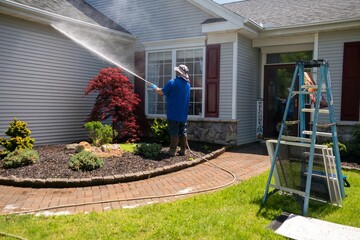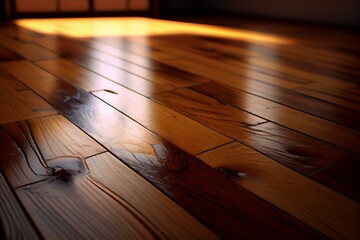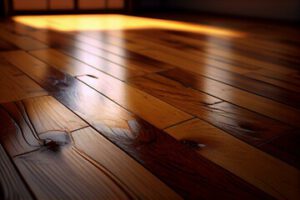Professional power washing services can drastically improve the cleanliness and overall appearance of your home or commercial property. In addition, regular power washing can prevent long-term damage to surfaces like siding and concrete.
Harmful substances like mildew, mold, and allergens can build up on the exterior of buildings. These substances can have a negative impact on people’s health, especially those with respiratory conditions. Visit https://www.certifiedsoftwash.ca/ to learn more.
Power washing is a process that uses pressurized water to clean surfaces. It is often combined with detergents to enhance its cleaning ability and effectiveness. The high-pressure water stream helps to loosen and remove dirt, dust, mud, mildew, algae, and other debris from surfaces, leaving them looking refreshed and rejuvenated. When performed correctly, it is a highly effective way of maintaining the cleanliness and appearance of various outdoor surfaces around homes and businesses.
Professional power washing services use specialized equipment to safely and effectively clean exterior surfaces. They are trained to know the proper pressure levels and detergents to use, ensuring that the surface is cleaned thoroughly without being damaged or over-washed. In addition, they understand how to apply the pressure evenly and consistently, removing contaminants from all areas of the surface.
Before beginning a power wash, the technician will assess the area to be cleaned and determine the appropriate water pressure level and detergent mixture. Then, they will prepare the area by moving any furniture or decor away from the area to be cleaned and covering nearby plants or electrical outlets with plastic sheeting to prevent damage. They will then begin the power washing process, carefully assessing the progress to make sure that the correct pressure levels are being used and that no damage is occurring.
Once the surface has been cleaned, it is rinsed with lower pressure to remove any remaining residue. This can also be done with a cleaner or detergent, which is specifically tailored to the surface type, for enhanced cleaning results. In some cases, a surface may require a second or third power washing to ensure that all contaminants have been removed.
Regular power washing can dramatically improve the cleanliness, beauty, and longevity of outdoor surfaces. It is an essential part of a property maintenance plan for homeowners and business owners alike. Whether it is a driveway, sidewalk, deck, building exterior, or roof, power washing can help to remove dirt, mildew, mold, and other debris that can mar the beauty of a home or business and lead to costly repairs.
Removes Stains
When paired with the right detergent, power washing is a powerful stain removal tool. The hot water temperature and high pressure help blast away dirt, grime, mold, mildew, and other stains. Unlike regular scrubbing, power washing can also remove grease, oil, and other sticky residue. This makes it ideal for surfaces like driveways, sidewalks, patios, home exteriors (brick, vinyl, and wood siding), fences, and even roofs. In fact, soft washing (a lower pressure form of power washing) is often used to remove mold and mildew from shingles without damaging the structure of the roof.
Over time, algae, mold, mildew, and other substances can eat away at surfaces, causing damage to your property. This can include wood rot, weakened structural integrity, and paint damage. Power washing regularly prevents these contaminants from destroying your property and helps it look newer, longer.
Whether your commercial or residential property is suffering from green slippery algae, dirt, mold, or ugly graffiti, a professional power wash will restore it to its former glory. This will make your property more appealing to visitors and potential customers, boosting your curb appeal.
When choosing a professional power wash service, it is important to find one that is licensed and insured. This will protect you in the event of any accidents or damages during the cleaning process. In addition, it is crucial to choose a company that has experience and knows how to handle various surfaces and materials. They should be able to determine the proper level of pressure for each surface and material, using only the amount necessary to clean it thoroughly without causing any damage.
The most common areas for power washing are driveways, sidewalks, and patios. Power washing these surfaces can lift stains caused by oil, rubber, and other liquids, as well as dirt, mud, and sand. In addition, it can remove slippery substances like mold and mildew from sidewalks and driveways, reducing the risk of injuries caused by falls. A professional power wash can also remove graffiti quickly and easily. This can save you the hassle and expense of repainting your property.
Prevents Mold and Mildew Growth
Power washing has been known to provide a multitude of benefits to the appearance and upkeep of your home or business. It helps prevent deterioration of surfaces, reduces allergens, and extends the lifespan of paint and siding. It also contributes to a healthier environment by eliminating harmful mold and mildew growth. Mold and mildew spores are dangerous to the health of building occupants, especially those with respiratory conditions or allergies. These fungi thrive in damp environments and can spread rapidly, leaving unsightly stains and unpleasant odors on surfaces.
Regularly scheduled power washing services can eliminate and prevent the buildup of mold and mildew. By keeping these contaminants away from your home or business, you can avoid costly repairs in the future. A professional power wash can also help prevent the onset of rot and damage to wood surfaces, as well as concrete and brick. Mold and mildew are often caused by moisture problems, such as leaky roofs or plumbing issues. If you suspect that these problems may be the cause of your mold or mildew problem, it’s a good idea to resolve them before getting your property power washed.
A professional can advise you on the best course of action to take if you believe that your home or commercial building may be susceptible to mold and mildew. For example, you can try applying a copper sulfate solution to your concrete or brick surfaces after a power wash to prevent mold and mildew growth in the future. This will not solve a current mold or mildew problem, however, so it’s important to follow up with other treatment options.
Overall, there are many reasons why you should include a regularly scheduled power washing service in your maintenance routine. Not only will it keep your home or commercial building looking its best, but it will also help protect your investment and ensure that your family or employees remain safe. A clean and healthy space will also be more attractive to potential tenants, boosting your property’s value in the real estate market. If you’re interested in scheduling a power washing service for your property, please contact us to discuss our services and pricing.
Environmentally Friendly
Professional power washing services use environmentally friendly cleaning solutions to minimize their impact on the environment. They are also experienced and trained in proper technique, which can ensure a thorough and effective clean without damage or injury to your property.
Power washing services can help minimize the spread of pests and disease by removing debris and sanitizing surfaces. These services are especially useful for properties with large exterior spaces that can harbor pests like spiders and ants. Power washing can remove these pests and the cobwebs they create, which can also make buildings look unkempt and run down.
The cleaning solution used during a power wash session can run off and enter nearby bodies of water, which can harm wildlife. However, eco-friendly cleaning solutions that are diluted properly and rinsed thoroughly can have minimal environmental impact. The best power washing companies take care to use only the amount of water needed for each job and ensure that all the cleanser solution is captured and disposed of correctly.
Another issue with traditional power washing is that it can damage and even kill plants and bushes. This is because the cleansing solution can add salt to the soil, making it difficult for them to soak up water and can dehydrate or even kill them. However, when professionals follow proper guidelines, this is not a problem. They should always spray plants with a low pressure setting, and they should soak and rinse them mid-treatment.
Whether you need to restore your home or business, or simply want to keep it looking its best, a professional power wash can be the perfect solution. However, not all power washing companies are the same, so be sure to choose a company with the right experience, training and equipment. Also, make sure they are licensed and insured for your protection. Finally, be sure to ask for references and a written quote before hiring them.





